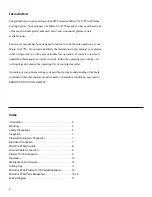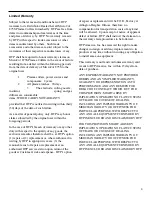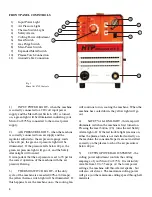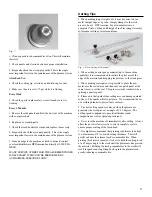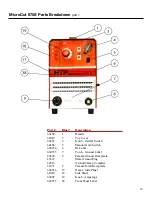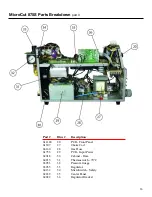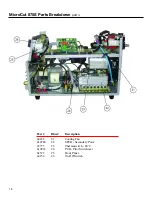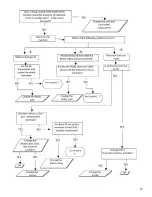
Safety Precautions
Plasma Arc Cutting Hazards
▲
The safety information given below is only a summary of
the more complete safety information found in the Safety
Standards listed in Section M. Read and follow
all Safety Standards.
▲
Only qualified persons should install, operate,
maintain, and repair this unit.
▲
During operation, keep everybody, especially children, away.
P
Plla
assm
ma
a C
Cu
uttttiin
ng
g cca
an
n cca
au
ussee ffiirree o
orr eexxp
pllo
ossiio
on
n..
Hot metal and sparks blow out from the plasma cutting
arc. The flying sparks and hot metal, hot work pieces,
and hot equipment can cause fires and burns. Check
and be sure the area is safe before doing any cutting.
Protect yourself and others from flying sparks and hot metal.
Do not cut where flying sparks can strike flammable material.
Remove all flammables within 35 ft of the plasma cutting arc.
If this is not possible, tightly cover them with approved
covers.
Be alert that sparks and hot materials from cutting can easily
go through small cracks and openings to adjacent areas.
Watch for fire, and keep a fire extinguisher nearby.
Be aware that cutting on ceiling, floor, bulkhead, or partition
can cause fire on the opposite side.
Connect ground cable to the work as close to cutting area as
practical to prevent cutting current from traveling long,
possibly unknown paths and causing electric shock and fire
hazards.
Do not cut pressurized cylinders, pipes, or vessels.
Do not cut on closed containers such as tanks or drums.
Never cut containers with potentially flammable materials
inside- they must be emptied and properly cleaned first.
Do not cut containers that have held combustibles.
Do not cut in atmospheres containing explosive dust or
vapors.
Wear oil-free protective garments such as leather gloves,
heavy shirt, cuffless trousers, high shoes, and a cap.
Do not locate unit on or over combustible surfaces.
Remove any combustibles, such as butane lighter or matches
from your person before doing any cutting.
E
Elleeccttrriicc S
Sh
ho
occkk cca
an
n kkiillll
Touching live electrical parts can cause fatal shocks or
severe burns. The plasma torch and circuit are
electrically live whenever the output is on. The input power
circuit and machine internal circuits are also live when power is
on. Plasma arc cutting requires higher voltages than welding to
start and maintain the arc (100 -300 volts dc are common), but
also uses torches designed with safety interlock systems which
turn off the machine when the shield cup is loosened or if tip
touches electrode inside the nozzle. Incorrectly installed or
improperly grounded equipment is a hazard.
Do not touch live electrical parts.
Wear dry, hole-free insulating gloves and body protection.
Insulate yourself from work and ground using dry insulating
mats or covers big enough to prevent any physical contact
with work or ground.
Do not touch torch parts if in contact with the work or ground.
Turn off power before checking, cleaning, or changing torch parts.
Disconnect input power before servicing this equipment.
Lockout/tagout input power according to OSHA CFR
1910.147
Properly install and ground this equipment according to the
Owner’s Manual and national, state, and local codes.
Check and be sure that input power cord ground wire is
properly connected to ground terminal in disconnect box or
that cord plug is connected to properly grounded receptacle
outlet-always verify the supply ground.
When making input connections, attach proper grounding
conductor first.
Frequently inspect input power cord, plasma torch and ground
cable for damage or bare wiring. Replace cord immediately if
damaged. Bare wiring can kill.
Turn off all equipment when not in use.
Do not wrap torch cable around your body.
Ground the work piece to a good electrical (earth) ground if
required by codes.
Use only well-maintained equipment. Repair or replace
damaged parts at once.
Wear a safety harness if working above floor level.
Keep all panels and covers securely in place.
Do not bypass or try to defeat the safety interlock systems.
Use only the Plasma Torch specified in the Owner’s Manual.
Keep away from torch tip and pilot arc when the plasma torch
trigger is pressed.
Clamp work cable with good metal-to-metal contact to work
piece (not piece that will fall away) or worktable as near the
cut as practical.
Insulate work clamp when not connected to work piece to
prevent contact with any metal object
.
S
SIIG
GN
NIIF
FIIC
CA
AN
NT
T D
DC
C V
VO
OL
LT
TA
AG
GE
E eexxiissttss o
on
n
iin
ntteerrn
na
all p
pa
arrttss o
off iin
nvveerrtteerr p
po
ow
weerr sso
ou
urrcceess
A
AF
FT
TE
ER
R tth
hee rreem
mo
ovva
all o
off iin
np
pu
utt p
po
ow
weerr
.
4
Summary of Contents for MicroCut 875S
Page 1: ...Mi c r o C u t 8 7 5 S ...
Page 17: ...17 MicroCut 875S Wiring Diagram ...
Page 18: ...18 ...
Page 19: ...19 ...
Page 20: ...20 ...


